Communications ready for Koolendong

Preparations are underway for high-end warfighting Exercise Koolendong, which is set to take place between elements of 1 Brigade and the US Marine Corps Marine Rotational Force Darwin (MRF-D).
CAPTION: US Marine Corps Lance Corporal Rodrigo Morales, left, Australian Army Signaller Richard Davis, US Marine Corps Lance Corporal Johnny Hernandez and Australian Army Signaller Kurt Bloomfield at Robertson Barracks. Story by Captain Peter March. Photo by Corporal Rodrigo Villablanca.
The exercise will be held during August and September at the Bradshaw Field Training Area, NT.
The live-fire exercise, which is the concluding activity for the current MRF-D deployment, aims to achieve proficiency in core mission essential tasks and to enhance integration between the two nations.
To ensure successful interoperability from the outset, personnel from 1 Combat Signal Regiment (1CSR) and the MRF-D established a Coalition Communications Formation Node on the Robertson Barracks parade ground for a mission readiness activity to confirm information exchange between coalition networks.
1CSR’s Captain Michael Wiggins explained the importance of these types of pre-exercise activities in order to help identify and address potential issues.
“Here we have Australian soldiers and United States Marines working side-by-side, working to confirm that everything is mission ready before we deploy to the field,” Captain Wiggins said.
“Some of the initial challenges that we’ve come across is from a communications security perspective, getting the integration between their national authorities to be able talk on the same networks within the coalition.”
Communications enable the two forces to not only walk the talk on exercises, but be ready to respond if needed during humanitarian aid tasks or in conflict.
Captain Michael Wiggins said Exercise Koolendong was used to confirm ADF and MRF-D posture for contingency and crisis response in the Indo-Pacific region.
“From a communications perspective, Exercise Koolendong confirms that everything we say about interoperability and the effect we’re able to achieve in the stable barracks environment, is also replicated and achievable in the field or if required, in an operationally contested environment,” he said.
Teams from 1CSR and MRF-D will spend three weeks in the field, communicating across about 6600km2 to keep 4000 troops connected during Exercise Koolendong.
.
.

.
.





